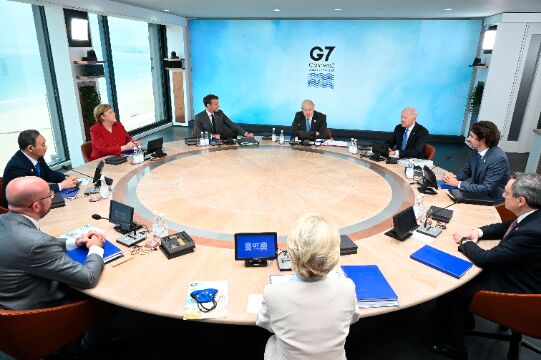A viable alternative?
The US-proposed B3W development initiative seeks to achieve twofold objectives — meeting the infrastructure needs of worst-hit nations and tackling China’s BRI

Among the announcements from the recent G7 meet, came a major initiative in the form of B3W (Build Back Better World) with the declared intent to counter the ambitious Belt and Road Initiative (BRI) — the signature plan of Chinese president Xi Jinping.
Amid the entire world, including the seven richest economies, exploring ways to re-energise trade and investments and repair the damage that economies incurred during the COVID-19 pandemic, US President Joe Biden is rallying the G7 to meet the "world's biggest challenges and demonstrate shared values".
The leaders do acknowledge that G7 faces strategic competition from China that has already sunk in billions of dollars in infrastructure projects in several countries, and that there is a need to come up with firm commitment and solid action that would go a long way in meeting the requirements of low and middle-income countries.
Take a look at the outline of the B3W plan which President Biden and G7 partners describe as a 'bold new global infrastructure' initiative to help narrow the USD 40 plus trillion infrastructure needs in different countries whose condition worsened during the global health pandemic.
The plan is to coordinate by mobilising the private sector in four focus areas of climate, health and health security, digital technology, and gender equity and equality. The funding would be from investments by development finance institutions of these countries.
The geographical spread for the B3W initiative stretches from South America and the Caribbean to Africa and Indo-Pacific, with partner countries taking responsibility for different countries under the overall approach of covering the target countries across the globe.
The United States, as the lead partner, identified some institutions through which it will channelise investments. These include the Development Finance Corporation, USAID, EXIM, the Millennium Challenge Corporation, and the US Trade and Development Agency along with complementary bodies such as the Transaction Advisory Fund.
It is undoubtedly an ambitious effort and the Biden administration has been candid that the approach dovetails its aim to shore up infrastructure in the United States itself. Earlier this year, President Biden unveiled a Build Back Better USD 4.5 trillion plan — USD 2.9 trillion investment for infrastructure and USD 1.6 trillion investment in labour-spending over the next 15 years, a timeframe similar to that for the B3W.
The idea is to complement domestic infrastructure investments by creating jobs in the United States and create opportunities afresh that can show how competitive America can be. This is also the G7 way of offering something concrete to the countries. Yet, till the complete plan that should have several moving parts is ready, its outcome will be difficult to determine.
It is unclear whether the 2019 Blue Dot Network (BDN) State Department plan will remain in place or be modified to work within the B3W. The BDN is a "multi-stakeholder" initiative that will bring together governments, the private sector and civil society to promote high-quality, trusted standards for global infrastructure development. It is a globally recognised evaluation and certification system for roads, ports and bridges with a focus on the Indo-Pacific region.
Interestingly, the European Union in its policy paper on Indo-Pacific published earlier this year, focuses on high-quality connectivity in the region. The paper said that the EU will continue to advance its quality and sustainable connectivity priorities through EU institutions and member states cooperating practically with partners on the ground; the priorities would address different dimensions including digital, transport, energy, and human and promote quality infrastructure projects consisting of highest standards of transparency and green and digital transition.
Political discourse in the United States is swirling around tackling the pandemic, Chinese threat, unemployment, investments and social equality issues accentuated in the run-up to the elections, and remain central to decision-making.
The philosophy behind B3W underscores that it will be values-driven, meet good governance and have strong standards; remain climate-friendly; create strong strategic partnerships; mobilise private capital through development finance; and enhance the impact of multilateral public finance. The thrust areas seek to address the problems countries are facing in dealing with the BRI-driven infrastructure works.
For example, there have been a number of instances around the world where countries, which are unable to service the debt taken from China in developing infrastructure projects, were forced to part with control of the asset. The Hambantota port in neighbouring Sri Lanka is a case in point. The criticism includes that the contract to build the BRI projects goes to Chinese companies that in turn arrive in the country with a complete workforce that does not benefit local workers.
Since its announcement in 2013, India opposes BRI as it does not offer a level playing field to businesses; and strongly objects to the China-Pakistan Economic Corridor as it passes through the Pak-Occupied Kashmir.
Views expressed are personal



